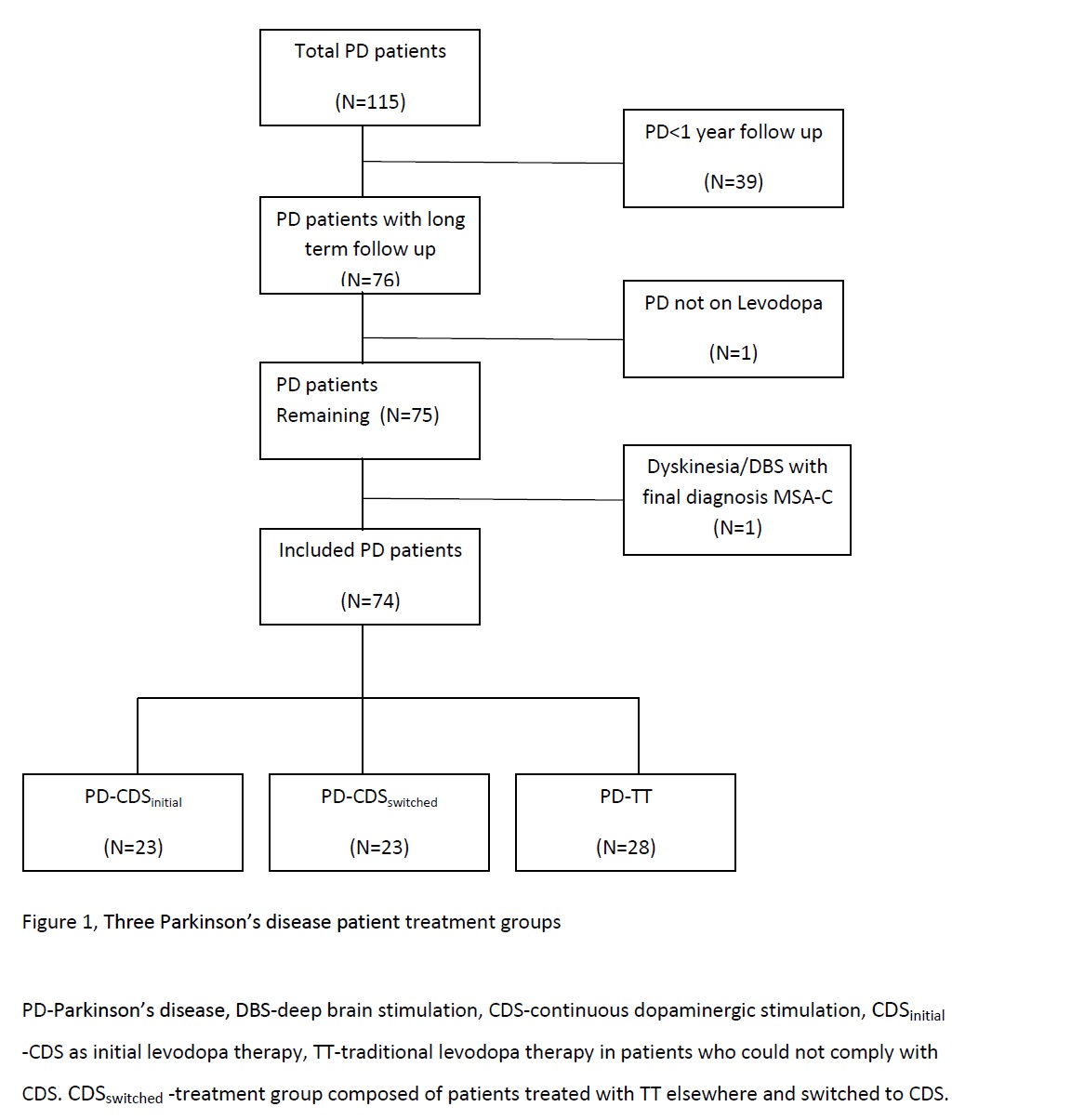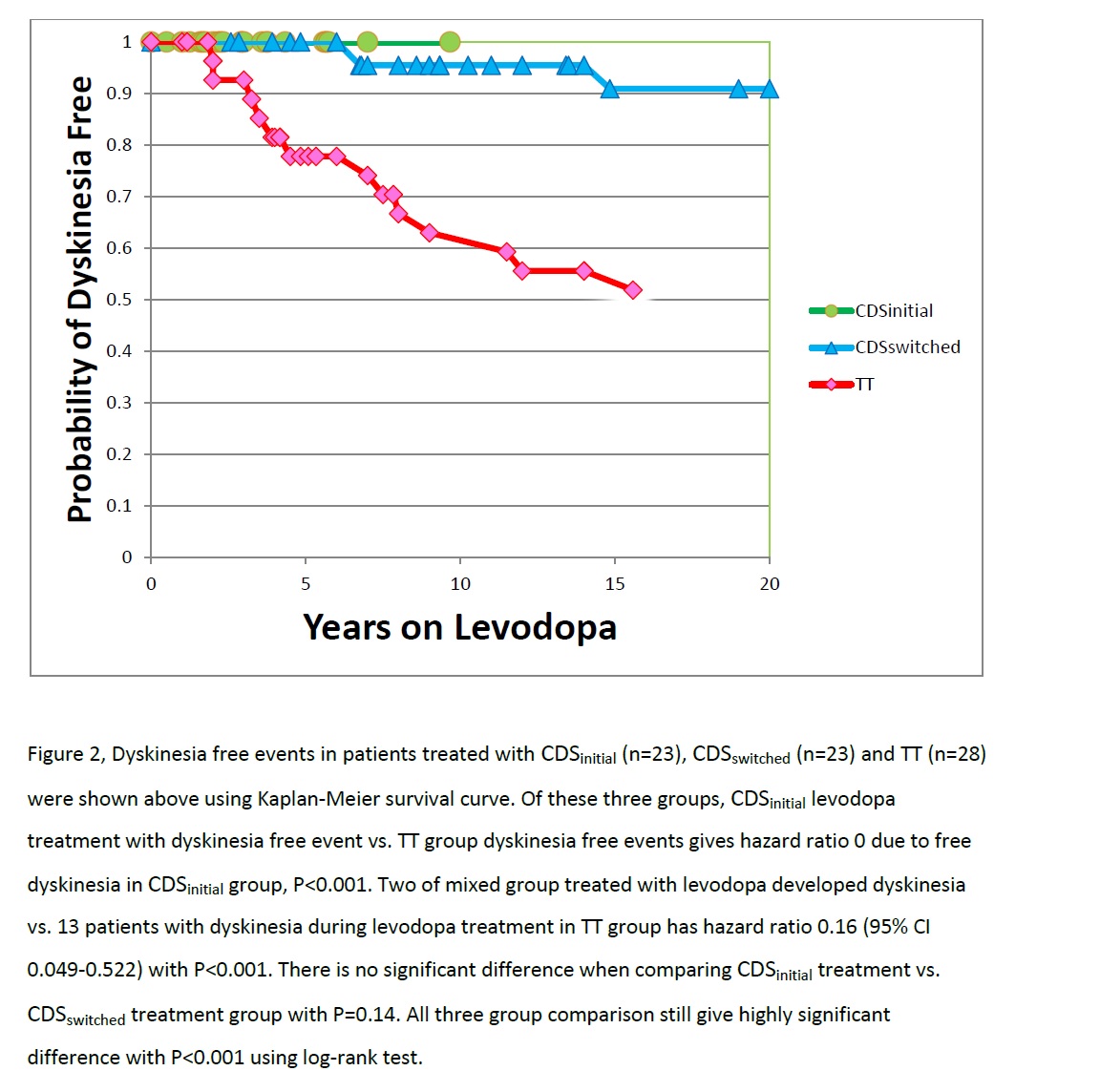Session Information
Date: Saturday, October 6, 2018
Session Title: Parkinson’s Disease: Clinical Trials, Pharmacology And Treatment
Session Time: 1:45pm-3:15pm
Location: Hall 3FG
Objective: To evaluate whether levodopa induced dyskinesia is preventable in the treatment of patients with Parkinson’s disease.
Background: Dyskinesia is one of the major complications of levodopa treatment of patients with Parkinson’s disease. Preclinical and clinical studies in advanced Parkinson’s disease have revealed that pulsatile dosing of levodopa is associated with the development of levodopa induced dyskinesia. Continuous dopaminergic stimulation (CDS) has reduced the risk of levodopa induced dyskinesia. We mimicked continuous dopaminergic stimulation in patients with Parkinson’s disease by giving small doses of levodopa frequently.
Methods: This is a retrospective case control study of patients with Parkinson’s disease treated at the movement disorders clinic of Medstar Washington Hospital Center between August 2002 and July 2017. We mimicked continuous dopaminergic stimulation by recommending 6 small daily doses of levodopa to all Parkinson patients. Patients who were observed for less than one year and patients who did not receive levodopa treatment were excluded from analysis.
Results: Of the 115 patients with Parkinson’s disease evaluated, 41 were excluded. The remaining 74 patients were divided into the three groups: 1. patients initially managed on continuous dopaminergic stimulation (CDSinitial n=23), 2. patients initially on traditional therapy who were switched to continuous dopaminergic stimulation (CDSswitched n=23), and 3. patients on traditional therapy through the observational period or until they developed dyskinesia (TT n=28). None of the CDSinitial patients developed dyskinesia (80 person-years of levodopa exposure), two of 23 patients in the CDSswitched group had dyskinesia (dyskinesia rate 0.92 per 100 person-years). Thirteen of 28 TT patients were found to have dyskinesia with a dyskinesia rate 7.83 per 100 person-years. The relative risk for developing dyskinesia in the TT group compared to the CDSswitched group is 8.5 while the relative risk for the TT group compared to the combined CDSinitial and CDSswitched groups is 11.7 (P<0.001).
Conclusions: A regimen of multiple (6 times daily) small doses of levodopa is associated with a significantly lower incidence of dyskinesia. Levodopa induced dyskinesia appears to be preventable.
References: Chase TN, Baronti F, Fabbrini G, Heuser IJ, Juncos JL, Mouradian MM. Rationale for continuous dopaminomimetic therapy of Parkinson’s disease. Neurology. 1989;39(11 Suppl 2):7-10; discussion 9. Stocchi F. The therapeutic concept of continuous dopaminergic stimulation (CDS) in the treatment of Parkinson’s disease. Parkinsonism Relat Disord. 2009;15 Suppl 3:S68-71.
To cite this abstract in AMA style:
M. Lin, R. Laureno. Levodopa induced dyskinesia is preventable (15 years experience using continuous dopaminergic stimulation) [abstract]. Mov Disord. 2018; 33 (suppl 2). https://www.mdsabstracts.org/abstract/levodopa-induced-dyskinesia-is-preventable-15-years-experience-using-continuous-dopaminergic-stimulation/. Accessed April 3, 2025.« Back to 2018 International Congress
MDS Abstracts - https://www.mdsabstracts.org/abstract/levodopa-induced-dyskinesia-is-preventable-15-years-experience-using-continuous-dopaminergic-stimulation/


